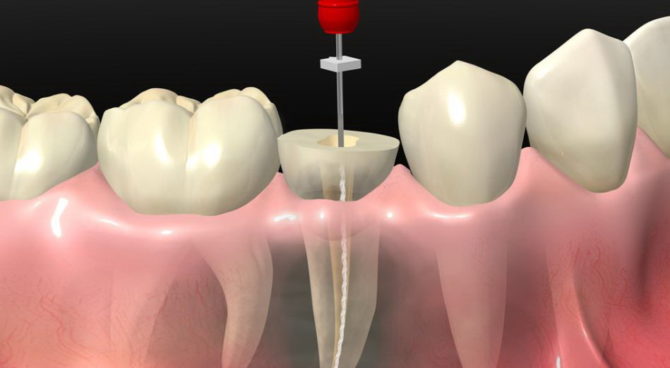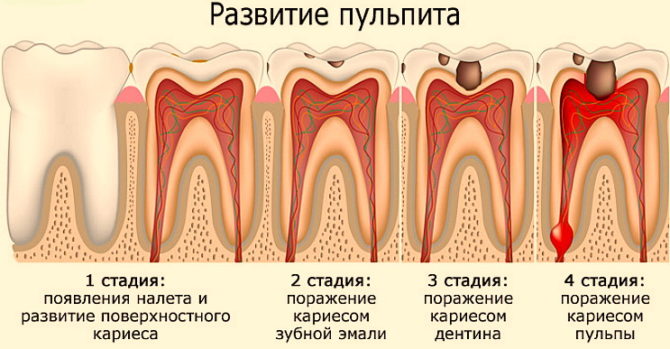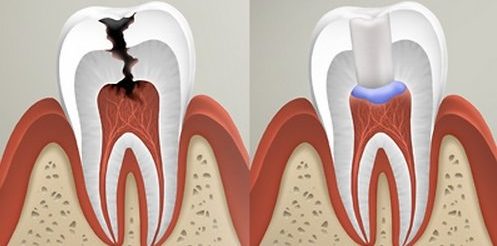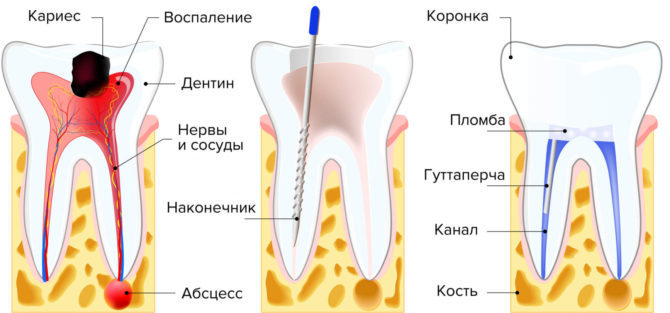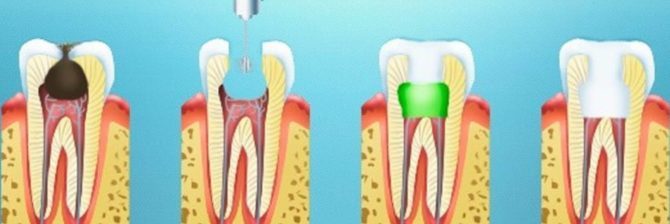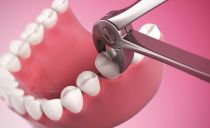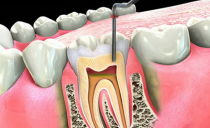What is tooth depulpation, methods of depulpation with prosthetics
Toothpulp is the removal of its pulp, consisting of fibrous connective tissue and filling the tooth canals. The method is used in the treatment of pulpitis - inflammation of the internal part of the tooth - and avoids the loss of an organ while fully maintaining its chewing function.
Content
Tooth removal - what is it
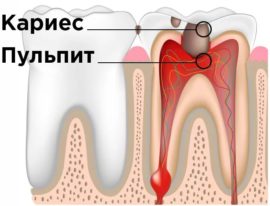 The structure of pulpis dentis (pulp) includes nerve endings, capillaries, lymphatic vessels. When exposed to infectious agents penetrating into the pulp from the carious cavities on the tooth surface, inflammation of the area under consideration develops - pulpitis. In most cases, the spread of the inflammatory process can be suppressed only by removing the nerve - extirpation. Such a procedure is called tooth removal.
The structure of pulpis dentis (pulp) includes nerve endings, capillaries, lymphatic vessels. When exposed to infectious agents penetrating into the pulp from the carious cavities on the tooth surface, inflammation of the area under consideration develops - pulpitis. In most cases, the spread of the inflammatory process can be suppressed only by removing the nerve - extirpation. Such a procedure is called tooth removal.
Manipulation is carried out under anesthesia, after a thorough assessment by the dentist of the general condition of the patient and the risk of complications that pulpectomy can lead to. Doctors resort to tooth pulp removal only if they fail to stop inflammation in other ways.
Factors contributing to the development of pulpitis
The progression of the disease is stimulated not only by the growth of colonies of pathogenic agents: streptococci, staphylococci, lactobacilli. The list of additional reasons contributing to the development of pulpitis:
- injury to the dental unit: opening the pulp chamber, large fracture of the crown, deformation of the root;
- the influence of chemicals - acrylic plastics, phenols, phosphoric acids - used in dentistry during filling and other activities;
- pulp reaction to temperature effects;
- the appearance of regional permeability due to shrinkage of the filling material or the human factor: incorrectly rendered services to restore the functionality of destroyed dental units.
The acute onset of the disease in a short period leads to the appearance of an abscess, purulent fusion of connective tissue. The inflammatory process is localized in the surrounding structures, causes pulp necrosis, the development of a chronic form of pathology. The patient begins to experience sharp shooting pain, discomfort when eating hot, cold food. Pulpitis can be prevented or neutralized by removing tooth pulp.
Indications and contraindications for tooth removal
Dentists pulp teeth with complex forms of pulpitis, which include:
- chronic - fibrous, hypertrophic, gangrenous;
- acute - diffuse, focal.
An additional indication for the pulp removal procedure is the presence of atrophied bone tissue, trauma, fracture, deep periodontal pockets - more than 2/3 of the total length of the tooth immersed in the jaw.
The doctor will definitely recommend the patient to have his tooth removed if he has a complaint of constant discomfort, aggravated at night. Patients are warned about the need for manipulation before prosthetics. In this case, it is carried out for preventive purposes: in order to avoid the development of pulpitis under the prosthesis.
In addition to the above indications, most dentists recommend that a tooth is pulped when intensive enamel abrasion, deep caries are detected.
Contraindications to the elimination of dental nerve endings is the presence in the patient's history of a number of diseases. Among them:
- stomatitis;
- mental disorders;
- ARI, ARVI;
- impaired functioning of the cardiovascular system;
- infectious hepatitis;
- blood diseases
- hemorrhagic diathesis.
Inflamed pulp tissue is not removed by women bearing a baby. Especially in late pregnancy.
Methods for implementing tooth deculpation
There are 5 methods of depulpation. The first one - biological - allows you to save the entire pulp or only its root region. Involving any of the remaining means partial or complete removal of tissue from the pulp chamber.
Biological pulp
Biological pulsation of teeth is used after accidentally opening the pulp, detecting a chronic fibrous or acute focal form of inflammation.
If the doctor recommended the patient this method of treatment of pulpitis, then:
- the disease began to develop less than 48 hours ago;
- the patient's age does not exceed 30–35 years;
- the patient does not have a reaction to percussion - light tapping on the tooth surface.
Briefly, the scheme of biological tooth depulpation is described in 5 stages. Before the tooth is depulpated, the doctor administers anesthesia to the patient, after which the carious cavity is thoroughly dried. Soft dentin tissue is removed by a dental excavator, boron. At the end of washing and secondary drying, a polyantibiotic paste is applied.
Observation of a pulsed tooth is carried out for 2 days. In the absence of complaints of discomfort, treatment ends with a permanent filling.
Vital amputation
Vital amputation is involved in the treatment of multi-rooted teeth. The algorithm for conducting this method of tooth pulsation consists of 4 stages:
- Anesthesia.
- The treatment of destroyed tissue.
- Removing the roof of the cavity, removing the coronal part of the pulp with special tools.
- Applying special toothpaste, artificial dentin, fillings to the depulped tooth.
Vital extirpation
Such a tooth depulpation procedure involves complete removal of the pulp and is performed under anesthesia. If the doctor has notified the patient that it is necessary to use vital extirpation, then the pulpitis was localized in the root of the pulp.
First, the standard stages of depulpation are performed - cleaning, opening the cavity, removing the coronal part of the pulp. Then the pulp is coagulated with a special apparatus - diathermocoagulator, and then removed. Root canals are filled with endodentum, phosphate cement or other material.
Devital extirpation
Devital extirpation of the tooth is a depulpation method that is used to completely eliminate inflamed connective tissues. In modern dentistry, the method is used quite rarely, since it involves the use of preparations based on arsenic, which means it is long-term and not entirely safe.
The affected root pulp is mummified by the use of special fluids. A permanent filling is applied to the depulped tooth in the third visit to the medical facility.
Combined method
According to the combined method, pulsation is carried out using a combination of the above procedures. Tactics are chosen by the doctor, taking into account the general well-being of the patient, the degree of tissue damage.
How to remove a tooth, only a specialist decides. You should not listen to the opinions of others who previously removed the nerve endings by using one of the procedures considered.
Results of depulpation
After elimination of pulpis dentis, the depulped tooth continues to perform chewing functions. Violation of the bite, as well as a change in the appearance of the dentition, is excluded. After depulpation, the patient retains the beauty and functionality of the tooth.
To maintain the integrity of the cured tooth, it is recommended to perform prosthetics. According to patient reviews, the life of a depopulated dental unit best prolongs the use of ceramic systems.
Prosthetics
Doctors of some medical clinics convince patients of the need to remove healthy dental nerves before installing an orthopedic design. Toothpulping is carried out before prosthetics to prevent the development of pulpitis and further preservation of the prosthesis. After all, to treat this disease, you will have to remove the crown, bridge or expensive and not subject to adjustment veneer.
However, many experts speak out against the removal of pulp without the presence of direct indications, since depulped teeth are characterized by increased brittleness and are more often destroyed.

